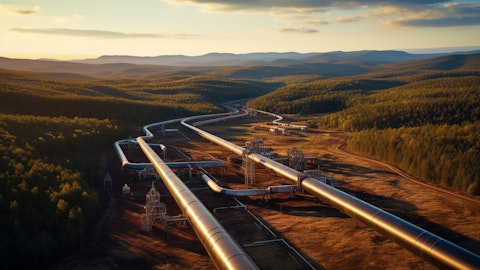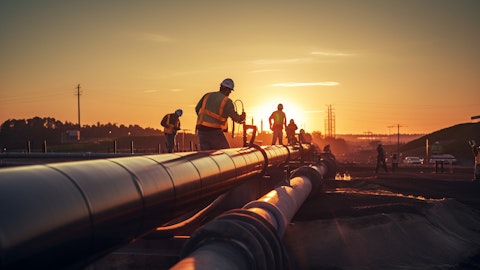And again I think it dovetails with the technology of an IP opportunity that we have that creates CNG and LNG opportunities for us. So more to come on that front. But we are pretty excited about what we have in our portfolio and those three different buckets combined is what’s going to drive New Tech cash flows in the coming years.
Zach Parham: Thanks, Ravi. Maybe my follow-up on the E&P business, 11 of your 35 planned turning lines in 2024 will be in the Central PA area versus the Southwest PA area which is up a bit from 2023. Can you just talk a little bit about what your future development split will look like? Will we see more activity shift to Central PA versus Southwest PA over time?
Ravi Srivastava: Yes, I think as we talked about historically, we are very focused on continuing to develop that Southwest PA asset. That’s where the bulk of our infrastructure is currently. And right now, we assess those opportunities on a NPV kind of total IRR basis. We did drill some CPA Utica wells this year. And we have talked about those, we expect those to come online next year and that’s some of the shales you are talking about. But overall, in the next few years, the mix should look pretty consistent that you have seen historically, but in the longer term, you wouldn’t see us migrate up towards CPA towards the latter part of the decade.
Zach Parham: Great. Thanks for the color, guys.
Operator: The next question comes from Leo Mariani with Roth MKM. Please go ahead.
Leo Mariani: Yes. Hi, I just wanted to follow-up a little bit on kind of production trajectory here in 2024. I know you guys only had kind of two shales in the fourth quarter. So just generally speaking, should we expect kind of production to dip a little bit here in the second quarter and then kind of start – kind of moving up as we get to the middle of the year and hit that guidance range? And I know that previously last year you kind of had the point estimate on guidance and this year you got a little bit of a range. So maybe just provide any kind of color around that would be helpful?
Alan Shepard: Yes, you will see kind of similar to what you saw last year. Q1 will probably be the low number for our volumes and that will build throughout the year. We should end the year at the highest kind of quarterly run-rate. But on average as we talked about, we are trying to maintain kind of a flat production profile on an annual basis about 580 Bcf.
Leo Mariani: Got it. Okay. That’s helpful. And then can you just talk a bit more about how you get from 2024 capital to 2025 capital, so you’ve got roughly $600 million this year and it’s expected to kind of step down to closer to $500 million next year. Can maybe just kind of talk us through a little bit what the kind of delta there is?
Alan Shepard: Yes, what you are seeing there is what we kind of set out to achieve right. We are going to hold production flat and focus on capital efficiency. And when you do whole production flat, you end up needing to turn in line fewer and fewer wells each year. So the ‘25 plan is going to you should expect to see fewer shales and with that comes lower capital, right, particularly on the completion side. So, that’s really the big driver there. We are not modeling any sort of cost reductions or anything that’s truly an activity based reduction.
Leo Mariani: Got it. So I am assuming a lot of this is probably just a function of lower decline rates as you continue to hold production flatter, it’s just taking fewer wells and is there also any kind of component that you are seeing where perhaps the wells have improved at all. I am just trying to get a sense of it’s a pretty big step down, alright, going from $600 million to $500 million, call it 17%, 18% less capital, it’s a really nice change in efficiency. We just wanted to see if there is any kind of well improvement performance component here.
Ravi Srivastava: Yes, I wouldn’t describe it as well improvement performance. I mean, we will have the CPA Utica wells in that plan next year and we expect those to be very robust like we saw in prior years. So really, it’s just to maintain 580, you hit it the production declines are lower, the capital intensity on the infrastructure side is lower and you end up with lower completion activity. So that’s right where we want to be.
Leo Mariani: Okay, thank you.
Ravi Srivastava: So we see a signal to grow production in this basin.
Leo Mariani: Yes, that makes sense. Thank you.
Operator: The next question comes from Michael Scialla with Stephens. Please go ahead.
Michael Scialla: Yes. Good morning, everybody. Maybe just to follow-up on Leo’s question there too. I am just curious so with that step down to $500 million, was there anything built in CapEx wise for the Adams Fork project in that timeframe or was that further out?
Nick DeIuliis: No, that was further out.
Michael Scialla: Okay, got it. And then your production guidance for this year, it looks like you are implying some mid single-digit growth year-over-year. Want to see how you see the in-basin fundamentals playing out this year and any concern about potential bottlenecks on storage or export capacity?





